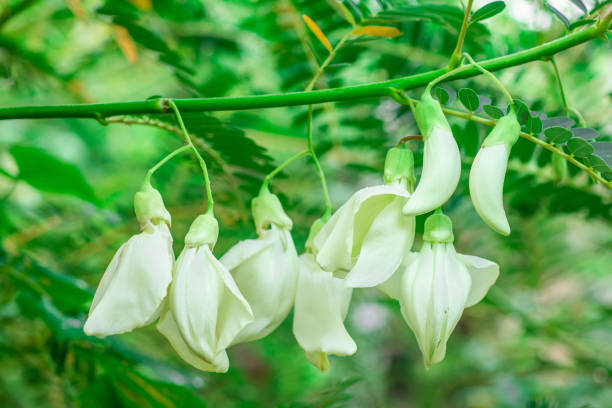

Sesbania grandiflora (L.) Poir.
|
It is commonly known as Agasti and belongs to the Fabaceae family. Flowers and fresh leaves are cooked and eaten as vegetable. The young leaves and the tender pods of this plant are used to supplement meals and as vegetables. Sesbagrandiflorain A, B and C, Saponin, Catechol, Quercetin, Oleanolic acid are some of the bioactive compounds reported from this plant. Methanolic extract of S. grandiflora possesses immunomodulatory and anti-cancer activity. Methanolic extract derived from S. grandiflora flowers not only potentiates nonspecific immune response, but also improves humoral as well as cell-mediated immunity effectively. Mode of Consumption : Fried and cooked |
| Plant Details | Agro-climatic Zone | Vernacular Names | Pictures |
| Scientific Name: Sesbania grandiflora (L.) Poir. Family: Fabaceae Lindl. Class: Magnoliopsida Order: Fabales Genus: Sesbania Adans. Fruiting Season: September to December (Flower), April-July (Fruit) Parts: Flower, Fresh leaves |
|
Assam : Bokphul Bihar : Hathya,Agasti, Gaach-munga Delhi : Hathya,Agasti, Gaach-munga Gujarat : Agathio Haryana : Hathya,Agasti, Gaach-munga Jharkhand : Hathya,Agasti, Gaach-munga Karnataka : Agase, Agasi Kerala : Akatti Madhya Pradesh : Hathya,Agasti, Gaach-munga Maharashtra : Shevari, Hatga Manipur : Houwaimal Rajasthan : Hathya,Agasti, Gaach-munga Tamil Nadu : Muni,Sevvagatti Telangana : Avisaku Uttar Pradesh : Hathya,Agasti, Gaach-munga Uttarakhand : Hathya,Agasti, Gaach-munga West Bengal : Agusta, Bagphal, Bak, Bake |
 Flowers |
| Compound/Extract | Activity | Mode of Action | Marker/References |
| Methanolic extract | Immunomodulatory | Methanolic extract derived from S. grandiflora flowers not only potentiates nonspecific immune response, but also improves humoral as well as cell-mediated immunity effectively. | B-cells and T-cells[3] |
| Methanolic extract | Immunomodulatory | Methanolic extracts of Sesbania grandiflora and Cocculus hirsutus both significantly increase or activate the secretion of immunoglobins such as IgM and IgG. Combining Sesbania grandiflora and Cocculus hirsutus in the ratio of 1:1 of 100-400mg/kg gives good immunomudulatory activity compared with 1:2 and 2:1 ratios. | IgM and IgG[4] |
| Methanol extract | Anticancer | The methanol extract of flowers of Sesbania grandiflora showed potential anticancer activity against Ehrich ascites carcinoma bearing Swiss albino mice. | [5] |
| Ethanolic extract | Hepatoprotective | Oral administration of ethanolic extract of Agathi leaves produced significant hepatoprotection against erythromycin estolate induced hepatotoxicity in rats. | [5] |
| Flower extract | Anticancer | Agathi flower extract significantly inhibited the growth of HeLa cancer cell line. | [5] |
| Protein fraction from flower | Anticancer, Chemopreventive | A novel protein fraction from Agathi flower shows potential anticancer and chemopreventive efficacy, against Daltons lymphoma ascites (DLA) and colon cancer cells (SW-480). | [5] |
| Ethanolic extract | Anticancer | Ethanol extract from leaves and flowers also exhibited anticancer activity in Ehrlich ascites carcinoma induced model in mice. | [5] |
| Methanol extract | Anti-inflammatory | The methanolic extract of Agathi registered profound anti-inflammatory activity against cotton pellet induced granuloma in the experimental rats. | [5] |
| Decoction | Antidiabetic | Among several immunomodulatory agents tested, interleukin 10 (IL-10) was assessed as a cytokine that could be used in the treatment of diabetes.Therefore, searching for herbal remedies capable of accelerating IL-10 production could be a rational strategy in the immunomodulatory therapy of diabetes treatment. S. grandiflora seed decoction (2.5 g/kg BW) could lower blood glucose of streptozotocin (STZ) induced diabetic mice. Relative amounts of interleukin-10 were increased significantly, indicating the role of IL-10 in maintaining blood glucose homeostasis. | IL-10[6] |
| Major Class | Metabolites (Content of bioactives: mg/100g Fresh Weight) |
| 2-(3,4-dihydroxy-2-methoxyphenyl)-4-hydroxy-6-methoxybenzofuran-3-carbaldehyde: , 2-(4-hydroxy-2-methoxyphenyl)-5,6 dimethoxybenzofuran-3-carboxaldehyde: [2] | |
| 2-arylbenzofuran | Sesbagrandiflorain A: , Sesbagrandiflorain B: , Sesbagrandiflorain C: [2] |
| Flavonoid | Quercetin: [1] |
| Flavonol glycoside | Kaempferol-3-routineoside: [1] |
| Glycosidic compound | Saponin: [1] |
| Phenol | Catechol: [1] |
| Triterpenoid | Oleanolic acid: [1] |
| Effect | Observation | DOI |
| Disease | Formulation | Reference | Author | TKDL |
| Internal abscess, Abdominal lump, Obesity, Headache | Varunadegan | Sharangadhara Samhita | Translated by Smt. Shailaja Srivastava | Ayurveda |
| Abscess | Varunadiganakwathampake | Sharangadhara Samhita | Translated by Smt. Shailaja Srivastava | Ayurveda |
| Fever with diarrhoea and vomiting | Maantha Kazichalku Marunthu | Yakkopu Vaithiyam | Yakkopu vaithiyam. Ed: Kuppusamy Naidu.Pub: Ramasamy kon (1967) | Siddha |
| Information from Wealth of India | Reference |
|
CSIR(1972).The Wealth of India, Raw materials,Vol.-IX ,P.295-298, New Delhi, India |
| 4.2, 4.2.1, 4.2.1.1, 4.2.1.3, 4.2.2.8, 4.2, 4.2.1, 4.2.1.1, 4.2.1.3, 4.2.2.8 |
| CSIR-North East Institute of Science and Technology, Jorhat-6, Assam, India
CSIR-Institute of Himalayan Bioresource Technology, Palampur-61,Himachal Pradesh, India |